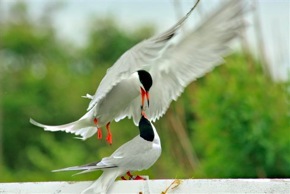Great Gull Island Today


North view of Great Gull Island
In 1981, Karl Koopman in the Mammalogy Department at AMNH suggested reintroducing a grass-eating rodent, the Meadow Vole (Microtus pensylvanicus). Robert W. Dickerman, a Research Associate in Ornithology at AMNH, trapped 35 voles in Westchester, N Y and he and Karl released them on Great Gull Island. At the end of 1982 there was not a blade of grass visible anywhere. By spring 1984, the voles had girdled all the bayberry at the western end of island. When volunteers took out this bayberry, the space available for nesting terns more than doubled and over 6,000 pairs of Common Terns nested. Vegetation, however, is a continuing problem. The plant species which replaced the grass in many areas are species the voles do not eat in any quantity. Since 1992 project staffer Matthew Male, disc harrows and rakes the island each spring to create cleared areas for nesting terns.
To monitor a species it is important to know, not only what affects success during the breeding season, but also what affects success in the nonbreeding period. Throughout most of the time volunteers worked on Great Gull Island no one knew where Roseate Terns spent the nonbreeding season. From 1995 through 2009 a Great Gull Island team checked sections of the South American coast in January, February or March looking for nonbreeding Roseate and Common Terns. While doing these surveys they met Pedro Lima in Brazil and Esteban Bremer in Argentina and developed cooperative projects with them. These projects produced invaluable data. In 2007 the Gull Island team working with Pedro Lima did a preliminary survey on the north coast of Brazil in Ceara. While there, Pedro introduced the Gull Island team to Alberto Campos from Aquasis, an NGO near the coast. Alberto agreed to work with the team on a tern conservation project on the north coast.
In addition to surveys in South America members of the Great Gull Island Project have participated in cooperative projects with researchers in the Azores and with individuals in Puerto Rico and the Virgin Islands to gather data on breeding as well as nonbreeding Roseate Terns.
On Great Gull Island each year teams mark Roseate and Common Tern nests with numbered tongue depressors: Common Terns the last weekend in May and the first weekend in June; Roseate Terns at the end of the first week in June. Once the tongue depressors are in place for Common Terns, a team marks each nest with a four-foot orange fiberglass dowel. When vegetation grows up around the nest, the dowel enables checkers to find the nest to band the chicks at hatching. Most Roseate nests are under the large boulders stabilizing the shoreline of the island, or on retaining walls of the fort in relatively open sites, so do not need dowels. At the time the chicks hatch, volunteers band them and begin trapping the adults on these nests. The teams try to trap pairs on each nest. They trap twice a day at 6:00 am and 6:00 pm. Most of the nests hatch the last two weeks in June, however hatching continues in a few nests through about August 10.
Between 1969 and 1984 1,500-2,000 pairs of Common Terns nested on Great Gull Island as well as 1,300 to 1,500 pairs of Roseate Terns. Predation by Black-crowned Night-Herons (Nycticorax nycticorax) limited success in the colony from 1978 to 1984. In addition, thick vegetation covered many areas formerly used by nesting terns. Throughout the period groups of volunteers tried different methods of clearing: fire, flooding with seawater, shoveling. In 1980, David Allen of Chesterfield Associates, a contracting company, lent the project a bulldozer and an operator for a day. A year later there was a second bulldozing in a different section of the island but the vegetation returned quickly.

Meadow Vole (Microtus pensylvanicus)
©Raymond A. Mendez
Copyright © 2011 Helen Hays